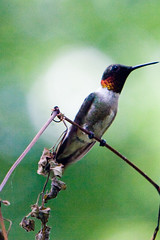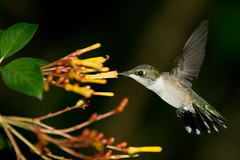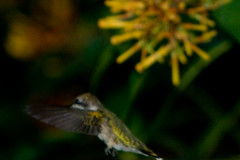
This little creature moves so fast that you may not know what it is. Is it a
bug? Is it a bumble bee? No! It is a Hummingbird! Darting hither and thither, one
can become crossed-eyed trying to follow its movement. Then suddenly, you see it
perching on the tiniest of twigs. It has to rest between feeding binges.
Watching these birds for several hours, one can see patterns emerge. This little male has several favorite perches. He prefers a tiny twig that is fairly long relative to his body size. The twig must give him a clear view of his domain. He is very possessive of his space. So he stays very busy chasing off would-be dinner guests. Thus the darting behavior.
Then came the female. She was allowed to feed when he was not in the neighborhood. It is my suspicion that he was out visiting his other girlfriend next door when I was able to catch some photos of this little lady. 
For the next couple of days, she was running off the others until the guy returned and chased her off. She fed more inside of the Hummingbird plants than did the male. She did not get up on the perches and monitor the area like he did. She would just attack everything that came to the table while in the backyard, then would disappear for as long as an hour. The female tended to catch more insects than the male. She would be high in the air at times, obviously catching something about 20-30 feet off the ground. That could have been flies or mosquitoes.
These are Ruby-throated Hummingbirds. They are the dominant and possibly only one of two species in this area. The other species is the Rufous. These Ruby-throated nest right here in our backyards. I suspect this one has a nest near here and is feeding her brood now, but she managed to keep me unaware of her nest. According to my bird book, she can be nesting as far away as 1.3 km and feeding here in my backyard. I noticed that each time she arrived, I could hear her chattering as if to say, "if there is anyone else here, you'd better leave". 
Don't think that the little lady is dull and only gray with white wing tips. She has the iridescence on her feathers that is typical of Hummingbirds. When the light hits her just right, you see these green and blue colors. As the sun reflects off of the bird in the flowers, her colors become very evident. The female is quite beautiful in fact. 
So the next time you go outside and have the opportunity to observe these beautiful and interesting creatures, try to see where the male is watching and if there are any females lurking around. Keep an eye for a family, maybe two youngsters and their mama. The male does not play a role in the upbringing of the brood. The female will protect them, but after a couple of weeks out of the nest, she will run them off to fend for their own well being, unlike the broods of other backyard birds.
Montgomery County had two observers participating in the 2006 Texas Hummingbird Roundup, reporting two species of Hummingbirds in the county.
Video:
References

